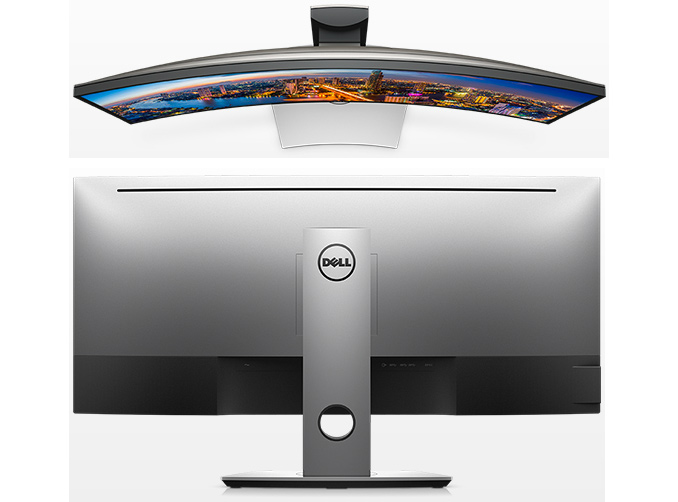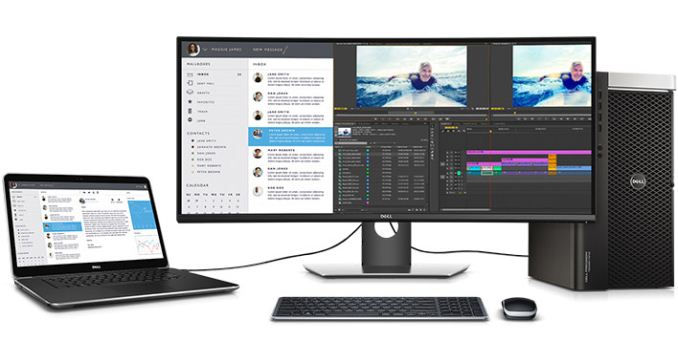Dell Unveils UltraSharp U3417W: Makes Its Curved Display More Curved
by Anton Shilov on September 14, 2016 11:00 AM EST- Posted in
- Monitors
- Dell
- IPS
- WQHD
- Ultrasharp
- Curved Display

Dell has unveiled its new top-of-the-range 34” curved monitor for consumers. The new UltraSharp U3417W display has the same WHQD resolution as the U3415W introduced a year ago, but increased curvature and a new chassis design. The monitor is aimed particularly at users who do heavy multitasking but do not want to install two monitors on their desks.
Nowadays, the majority of display makers position their curved monitors primarily for gamers and multimedia enthusiasts, thus, trying to incorporate very high refresh rates along with dynamic refresh rate technologies like AMD’s FreeSync or NVIDIA’s G-Sync. Meanwhile, Dell, quotes IDC’s findings that professionals from many industries (including those, who do finance, accounting and creative work) can benefit both from ultra-wide 21:9 aspect ratio as well as curvature. As a result, Dell offers curved monitors specifically tailored for professionals. Back in April, 2015, the company released its first U3415W curved display and this month it unveiled a newer model, the U3417W.
The Dell UltraSharp U3417W has higher curvature than its predecessor: 1900R vs 3800R. All the other specifications are generally similar: an IPS panel with 3440×1440 resolution, 1000:1 contrast ratio, 300 nits brightness, 178°/178° viewing angles, 5 ms response time in fast mode and a 60 Hz refresh rate. Dell believes that slightly higher curvature will further improve professional productivity.
| Dell's Curved Displays | ||
| UltraSharp U3417W 2016 model |
UltraSharp U3415W 2015 model |
|
| Panel | 34" IPS | |
| Native Resolution | 3440 × 1440 | |
| Maximum Refresh Rate | 60 Hz | |
| Response Time | 5 ms in fast mode 8 ms in normal mode |
|
| Brightness | 300 cd/m² | |
| Contrast | 1000:1 | |
| Viewing Angles | 178°/178° horizontal/vertical | 172°/178° horizontal/vertical |
| Curvature | 1900R | 3800R |
| Pixel Pitch | 0.233 mm | 0.2325 mm |
| Pixel Density | 109 ppi | unknown |
| Anti-Glare Coating | Yes | |
| Diagonally Viewable Size | 86.72 cm 34.14 Inches |
86.5 cm 34.055 inches |
| Preset Display Area | 799.80 mm × 334.80 mm 31.49" × 13.18" 267773.04 mm² 415.01 inches² |
798.20 mm × 334.80 mm 31.43" × 13.18" 267237.36 mm² 414.2474 inches² |
| Inputs | 1 × DP 1.2 (HDCP 1.4) 1 × mDP 1.2 (HDCP 1.4) 1 × DP 1.2 (out) with MST (HDCP 1.4) 2 × HDMI 2.0 (HDCP 1.4) |
1 × DP 1.2 1 × mDP 1.2 1 × DP 1.2 (out) with MST 1 × HDMI 2.0 1 × MHL |
| USB Hub | 4-port USB 3.0 hub, two ports support fast charging 2 USB Type-B upstream ports |
|
| Audio | 9 W × 2 audio in/out ports |
|
| Launch Price | $1199.99 | |
When it comes to connectivity, the UltraSharp U3417W resembles other modern monitors from the company (e.g., the UP3017) designed for professionals as it supports two HDMI 2.0, one DP 1.2, and one mDP 1.2 inputs. For convenience, it has one DP 1.2 output with MST to for daisy-chaining to another display. Besides, the monitor also supports PBP and PiP features when connected to two PCs. Finally, it has a quad-port USB 3.0 hub with two receptacles supporting BC 1.2 charging as well as two USB Type-B upstream ports (to connect to two different computers).
The Dell UltraSharp U3417W curved display is available now for $1199.99 from the manufacturer. Meanwhile, the older model, the U3415W is now available for $899.99. It is unknown whether Dell will keep selling both models, but for now the previous-gen display is available for the price, which is $300 below its original MSRP.
Source: Dell


















36 Comments
View All Comments
ikjadoon - Wednesday, September 14, 2016 - link
Why is pixel density unknown on the 2015 model? It's also a 3440x1440p 34" monitor, right?chekk - Wednesday, September 14, 2016 - link
I wonder whether the backlight bleed at the corners is resolved in this new model. I got used to it fairly quickly on my U3415W, but it was disappointing for a premium product with a premium price tag. Overall, this form factor and pixel density is very nice.xthetenth - Thursday, September 15, 2016 - link
That's a shame about backlight bleed. It's a random thing as far as I can tell, I've had good luck with my ultrawides (34UM95, U3415W, and XR341CK), and the only time the faint backlight bleed on my U3415W was noticeable at all in use was when I broke it in playing Alien: Isolation in a dark room. That was a mistake, for the record.AnnonymousCoward - Wednesday, September 14, 2016 - link
> like AMD’s FreeSync or NVIDIA’s G-SyncPlease don't call it "AMD's". VESA Adaptive-Sync is a license-free standard that's backed by many companies including Intel. By calling it AMD vs NVIDIA you're pitting companies against each other and discouraging NVIDIA from supporting VESA, prolonging incompatibilities.
JoeyJoJo123 - Thursday, September 15, 2016 - link
Well, AMD did pioneer that specific technology, just like Sony and a few other media companies pioneered Blu-Ray disk technologies. Unlike nVidia, AMD was able to get its adaptive sync technology adopted as an optional VESA standard protocol.Besides, the statement isn't as dividing between the two companies as you make it out to be. The only thing keeping nVidia from optionally supporting the VESA adaptive sync protocol is the fact that they're actively developing walled-garden technologies (Gsync) which requires you to both invest in nVidia GPUs and nVidia approved monitors. If nVidia GPUs supported VESA adaptive sync, there'd be a lot less sales in Gsync monitors, as Freesync enabled monitors have a price differential of $100 (or more) cheaper than the Gsync counterparts.
AnnonymousCoward - Wednesday, September 14, 2016 - link
Why can't Dell lead the way with specifying the critical spec of lag? Instead they list all these other specs that don't even matter (viewing angle, contrast ratio, preset display area?, pixel pitch, ...). Why do we have to wait until a reviewer tests lag, and then have to live with whatever accuracy they were able to achieve with their method???JoeyJoJo123 - Thursday, September 15, 2016 - link
>specifying the critical spec of lag1) What do you mean by "lag"? There's several different kinds of lag when it comes to monitor. Input Lag vs. Display Lag vs. Signal Processing?
I'll assume you mean total lag, from mouse movement to movement on the screen. Lag depends on several different factors.
1) The video port you use. (Yes, in some cases some video ports will have less lag than others on a given monitor.)
2) The transition between which colors to what other colors. (Gray-To-Gray changes are slightly faster.)
3) Whether any pixel overdrive is enabled at all during the test.
4) Full-chain input lag is also affected by the responsiveness of the mouse all the way down to the monitor, which is outside the scope of the monitor's capabilities. In other words, no matter how low lag the monitor may be, it cannot reduce lag of other components such as the mouse or computer.
TFT Central articles talk in depth about the method they use for testing lag and even then it estimates the display signal processing time component. Lag comparisons are also only valid when compared using the same tests. That means that some measurements using the Leo Bodnar Lag Testor tool will receive different results than someone using the same equipment and measurement methods that TFT Central uses.
Ultimately, there's no standard in measuring "lag" and therefore, Dell has no reason to shoot themselves in the foot by advertising unofficial lag specs. If they claim 20ms of total lag, someone using a Leo Bodnar Lag Testor may come up with a figure of 32ms and complain that Dell's specification is misrepresentation of the actual product, even though they may have used a completely different tool to measure the total lag and that the tool, in fact, does result in a figure of 20ms.
AnnonymousCoward - Thursday, September 15, 2016 - link
You just said there's no standard and then reference Leo Bodnar.I don't really care what method they use: CRT mirror, Leo, oscilloscope. It would be something. So we don't have to wait for somebody to review it and identify this key spec. It would also give Dell control over how its measured rather than rely on some shotty reviewer who might measure it wrong!
JoeyJoJo123 - Thursday, September 15, 2016 - link
The Leo Bodnar Lag Tester device is not an industry-standard lag testing tool. It's simply a device sold by a very specific British company, and isn't available in the US or other countries unless it's imported.It has an HDMI output and outputs either 1080p or 720p video to a monitor. It has a sensor at the bottom of the device which scans the monitor to detect the differential between when it generates a stimulus and the time at which the sensor detects it on the screen.
And to make matters worse, given that the Leo Bodnar Lag Tester tool always outputs a fixed resolution video signal, most monitors will experience additional lag if it's not the native resolution of the display, in which case it has to scale the video to fit the screen. In some cases, the difference between testing lag at native and non-native resolutions can be absurd, see the Dell U2417H review on TFT Central.
"Correction 16/8/16: We've had a few emails about the lag on the U2417H since we published this review, and comparisons with the measurement made at PCmag where they had used the Leo Bodnar device to measure a 10.2ms total lag. We can't really comment on the accuracy or otherwise of that device, but something didn't seem right. We will hold our hands up here as it looks like we've made a mistake with the lag measurements of this screen. The important thing is correcting that now, as we're sure it has an influence on people looking at buying this screen. Thanks to our friends at Pcmonitors(dot)info who are currently testing the HA model with the same SMTT 2.0 tool we use we've managed to figure out what has happened here and corrected our measurement results above. It seems that (very unusually) the U2417H shows an increased lag when non-native resolutions are used on the screen..."
That should illustrate the innate differences between measuring "lag" through different measurement methods.
stun - Wednesday, September 14, 2016 - link
What I am interested in is a newer model for the Dell's 5K monitor UP2715K.I hope they release a newer model that fixes the wake-from-standby issue, and with a DisplayPort 1.3.